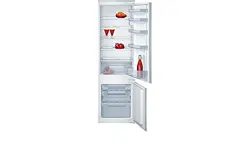Documents: Go to download!
User Manual
- Owner's manual - (English)
- Energy information - (English)
- Product spec sheet - (English)
- EU Datasheet - (English)
- EU Energy Label - (English)
- Installation instructions - (English)
- Installation location
- Connecting the appliance
- Getting to know your appliance
- Switching the appliance on
- Setting the temperature
- Usable capacity
- Refrigerator compartment
- Freezer compartment
- Max. freezing capacity
- Freezing and storing food
- Freezing fresh food
- Super freezing
- Thawing frozen food
- Interior fittings
- Sticker “OK”
- Switching off and disconnecting the appliance
- Defrosting
- Cleaning the appliance
- Tips for saving energy
- Operating noises
- Eliminating minor faults yourself
Table of contents
Installation location
Install the appliance in a dry, well ventilated room. The installation location should neither be exposed to direct sunlight nor near a heat source, e. g. a cooker, radiator, etc. If installation next to a heat source is unavoidable, use a suitable insulating plate or observe the following minimum distances to a heat source:
■ 3 cm to electric or gas cookers.
■ 30 cm to an oil or coal-fired cooker.
Connecting the appliance
After installing the appliance, wait at least 1 hour until the appliance is switched on. During transportation the oil in the compressor may have flowed into the refrigeration system. Before switching on the appliance for the first time, clean the interior of the appliance (see chapter “Cleaning the appliance”).
Electrical connection
The socket must be near the appliance and also freely accessible following installation of the appliance.
The appliance complies with the protection class I. Connect the appliance to 220–240 V/50 Hz alternating current via a correctly installed socket with protective conductor. The socket must be fused with a 10 to 16 A fuse.
For appliances operated in nonEuropean countries, check whether the stated voltage and current type match the values of your mains supply. This information can be found on the rating plate.
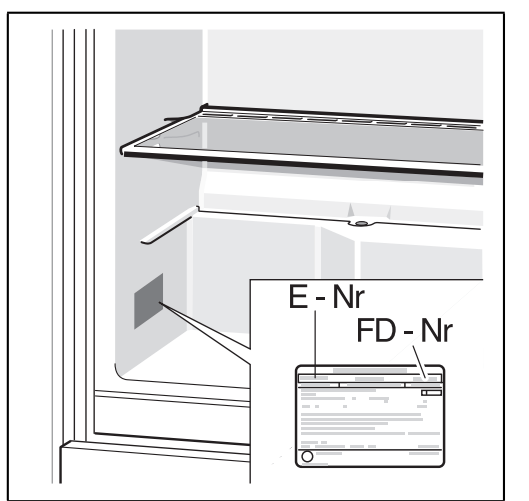
 Warning
Warning
Never connect the appliance to electronic energy saver plugs. Our appliances can be used with mains and sine-controlled inverters. Mainscontrolled inverters are used for photovoltaic systems which are connected directly to the national grid. Sine-controlled inverters must be used for isolated applications (e.g. on ships or in mountain lodges) which are not connected directly to the national grid.
Getting to know your appliance
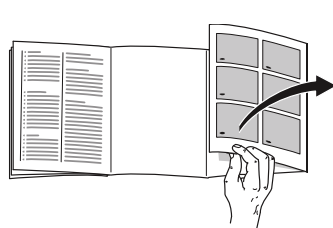
Please fold out the illustrated last page.
These operating instructions refer to several models. The features of the models may vary.
The diagrams may differ.
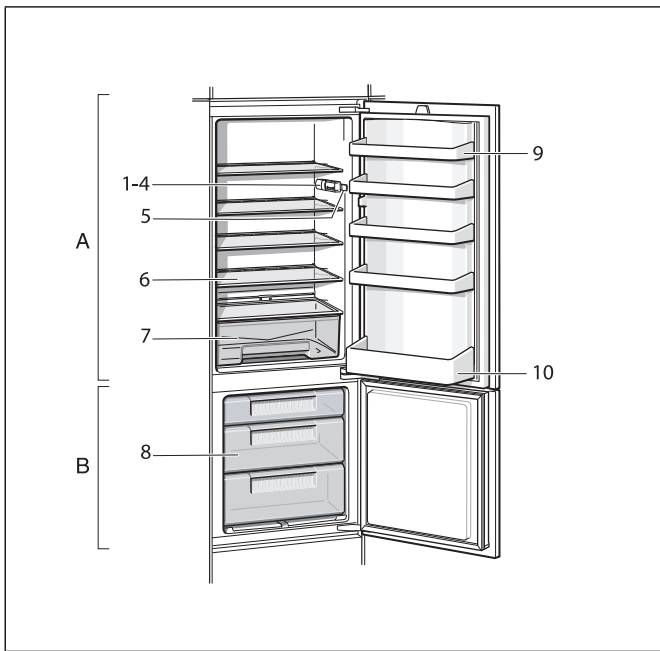
A Refrigerator compartment
B Freezer compartment
1-4 Controls/light
5 Light switch
6 Glass shelf
7 Vegetable container
8 Frozen food container
9 Door shelf
10 Shelf for large bottles
Controls

1. Main On/Off switch Serves to switch the whole appliance on and off.
2 “super” button Switches super freezing on and off. Illuminates when super freezing is on.
3 Temperature display refrigerator compartment The numbers correspond to the set refrigerator compartment temperatures in °C.
4 Refrigerator compartment temperature selection button The button sets the temperature in the refrigerator compartment.
Switching the appliance on
Switch on the appliance with the main On/Off switch
The temperature display, flashes until the appliance has reached the set temperature.
The appliance starts to cool, the light is switched on when the door is open. We recommend a factory setting of +4 °C in the refrigerator compartment. Do not store perishable food warmer than +4 °C.

Operating tips
■ After the appliance has been switched on, it may take several hours until the set temperature has been reached. Do not put any food in the appliance beforehand.
■ While the refrigeration unit is running, water droplets or hoarfrost may form at the rear panel of the refrigerator. This is due to functional reasons. It is not necessary to scrape off the frost or wipe off the water droplets. The rear panel defrosts automatically. The condensation collects in the drainage channel and is carried to the refrigeration unit where it evaporates.
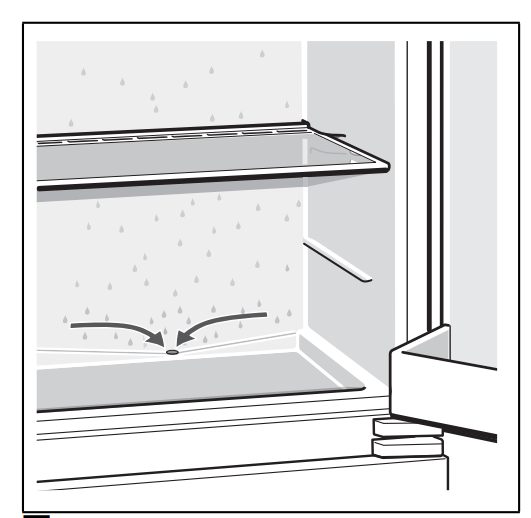
Setting the temperature

Refrigerator compartment
The temperature can be set from +2 °C to +8 °C.
Keep pressing temperature setting button on refrigerator compartment 4, until the required refrigerator compartment temperature is set. The value last selected is saved.
The set temperature is indicated on the temperature display for the refrigerator compartment 3.
Freezer compartment
The temperature in the freezer compartment depends on the temperature in the refrigerator compartment.
Lower temperatures in the refrigerator compartment also cause lower temperatures in the freezer compartment.
Usable capacity
Information on the usable capacity can be found inside your appliance on the rating plate

Fully utilising the freezer volume
The maximum amount of food can be placed in the freezer by removing all fittings. The food can be stacked directly on the shelves and in the bottom of the freezer compartment.
Removing the fittings
Pull out the frozen food container all the way, lift at the front and remove.
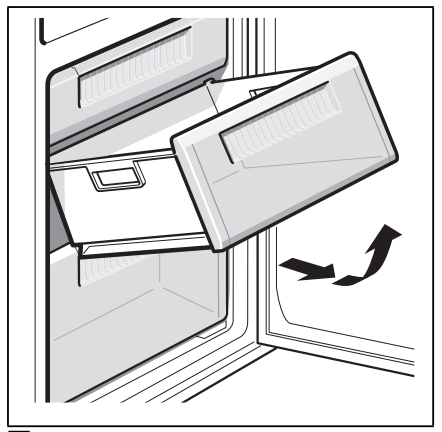
Refrigerator compartment
The refrigerator compartment is the ideal storage location for meat, sausage, fish, dairy products, eggs, ready meals and pastries.
Storing food
■ Store fresh, undamaged food. The quality and freshness will then be retained for longer.
■ In the case of ready-made products and bottled goods, observe the bestbefore date or use-by date specified by the manufacturer.
■ To retain aroma, colour and freshness, pack or cover food well before placing in the appliance. This will prevent the transfer of flavours and the discolouration of plastic parts in the refrigerator compartment.
■ Allow warm food and drinks to cool down before placing in the appliance.
Note
Avoid contact between food and rear panel. Otherwise the air circulation will be impaired.
Food or packaging could freeze to the rear panel.
Freezer compartment
Use the freezer compartment
■ To store deep-frozen food.
■ To make ice cubes.
■ To freeze food.
Note Ensure that the freezer compartment door has been closed properly. If the door is open, the frozen food will thaw. The freezer compartment will become covered in thick ice. Also: waste of energy due to high power consumption!
Max. freezing capacity
Information about the max. freezing capacity within 24 hours can be found on the rating plate

Prerequisites for max. freezing capacity
■ Switch on super freezing before placing fresh products in the compartment (see chapter entitled “Super freezing”).
■ Remove the fittings. The food can be stacked directly on the shelves and in the bottom of the freezer compartment.
■ Freeze large quantities of food preferably in the very top compartment where food freezes particularly quickly and therefore also gently.
Freezing and storing food
Purchasing frozen food
■ Packaging must not be damaged.
■ Use by the “use by” date.
■ Temperature in the supermarket freezer must be -18 °C or lower.
■ If possible, transport deep-frozen food in an insulated bag and place quickly in the freezer compartment.
Note when loading products
■ Preferably freeze large quantities of food in the top compartment, where food freezes particularly quickly and therefore also gently.
■ Place the food over the whole area of the compartments or the frozen food containers.
Note
Food which is already frozen must not come into contact with the food which is to be frozen. If required, move the frozen food to other frozen food containers.
Storing frozen food
Insert frozen food container all the way to ensure unrestricted air circulation.
Freezing fresh food
Freeze fresh and undamaged food only. To retain the best possible nutritional value, flavour and colour, vegetables should be blanched before freezing. Aubergines, peppers, zucchini and asparagus do not require blanching. Literature on freezing and blanching can be found in bookshops.
Note
Keep food which is to be frozen away from food which is already frozen.
■ The following foods are suitable for freezing: Cakes and pastries, fish and seafood, meat, game, poultry, vegetables, fruit, herbs, eggs without shells, dairy products such as cheese, butter and quark, ready meals and leftovers such as soups, stews, cooked meat and fish, potato dishes, soufflés and desserts.
■ The following foods are not suitable for freezing: Types of vegetables, which are usually consumed raw, such as lettuce or radishes, eggs in shells, grapes, whole apples, pears and peaches, hard-boiled eggs, yoghurt, soured milk, sour cream, crème fraîche and mayonnaise
Super freezing
Food should be frozen solid as quickly as possible in order to retain vitamins, nutritional value, appearance and flavour.
Several hours before placing fresh food in the freezer compartment, switch on super freezing to prevent an unwanted temperature rise.
This appliance runs constantly and the freezer compartment drops to a very low temperature.
If the max. freezing capacity is to be used, super freezing must be switched on for 24 hours before the fresh produce is placed in the freezer compartment.
Smaller quantities of food (up to 2 kg) can be frozen without “super freezing”.
Note
When super freezing is switched on, increased operating noises may occur.
Switching on and off

Press “super” button 2.
If the super freezing has been switched on the button is lit.
Super freezing automatically switches off after approx. 2½ days
Note During super freezing the refrigerator compartment becomes a little colder.
Thawing frozen food
Depending on the type and application, select one of the following options:
■ at room temperature
■ in the refrigerator
■ in an electric oven, with/without fan assisted hot-air
■ in the microwave
Caution
Do not refreeze thawing or thawed food.
Only ready meals (boiled or fried) may be refrozen. No longer store the frozen produce for the max. storage period.
Interior fittings
Glass shelves

You can reposition the inner shelves as required: lift shelf, pull forwards, lower and swivel out to the side.
Bottle shelf

Bottles can be stored securely on the bottle shelf. The holder can be adjusted.
Sticker “OK”
The “OK” temperature monitor can be used to determine temperatures below +4 °C. Gradually reduce the temperature if the sticker does not indicate “OK”.
Note
When the appliance is switched on, it may take 12 hours until the temperature is reached.

Correct setting
Switching off and disconnecting the appliance
Switching the appliance off

Press the main On/Off switch 1 (red circle becomes visible).
Temperature display goes out. Fridge and light are switched off.
Disconnecting the appliance If you do not use the appliance for a prolonged period:
1. Switch off the appliance.
2. Pull out mains plug or switch off fuse.
3. Clean the appliance.
4. Leave the appliance door open.
Defrosting
Refrigerator compartment defrosts fully automatically
While the refrigerating unit is running, beads of condensation or hoarfrost form at the back of the refrigerator compartment. This is quite normal. It is not necessary to wipe off the condensation or frost. The rear panel defrosts automatically. The condensation runs into the condensation channel, and is conveyed to the refrigerating unit where it evaporates.
Note
Keep the condensation channel and drainage hole clean, so that the condensation can run out.
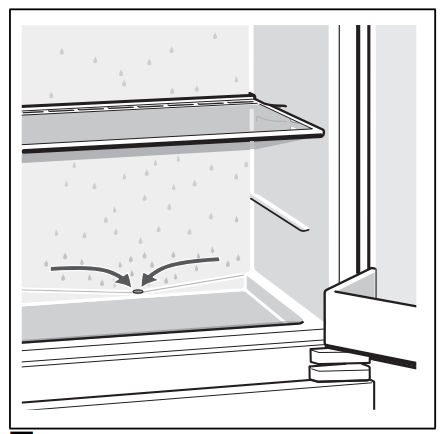
Defrosting the freezer compartment
The freezer compartment does not defrost automatically, otherwise the frozen food would start thawing. A layer of frost in the freezer compartment impairs refrigeration of the frozen food and increases power consumption. Remove the layer of hoarfrost regularly.
Caution
Do not scrape off hoarfrost or ice with a knife or pointed object. You could damage the refrigerant tubes. Leaking refrigerant may ignite or cause eye injuries.
Proceed as follows:
Note
Approx. 4 hours before defrosting the appliance, switch on super freezing so that the food drops to a very low temperature and can therefore be stored at room temperature for a longer period.
1. Remove the frozen food and place temporarily in a cool location.
2. Switch the appliance off.
3. Pull out the mains plug or remove the fuse.
4. To accelerate the defrosting process, place a pan of hot water on a trivet in the freezer compartment.
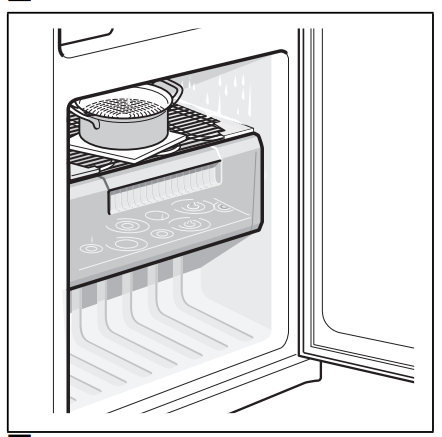
5. Wipe up condensation with a cloth or sponge.
6. Wipe dry the freezer compartment.
7. Switch the appliance on again.
8. Put the frozen food back in the freezer compartment.
Cleaning the appliance
Caution
■ Do not use abrasive, chloride or acidic cleaning agents or solvents.
■ Do not use scouring or abrasive sponges. The metallic surfaces could corrode.
■ Never clean the shelves or containers in the dishwasher. The parts may become deformed!
Proceed as follows:
1. Before cleaning: Switch off the appliance.
2. Pull out the mains plug or switch off the fuse!
3. Take out the food and store in a cool location. Place ice pack (if available) on the food.
4. Wait until the layer of frost has thawed.
5. Clean the appliance with a soft cloth, lukewarm water and a little pH neutral washing-up liquid. The rinsing water must not run into the light or through the drainage hole into the evaporation area.
6. Wipe the door seal with clear water only and then wipe dry thoroughly.
7. After cleaning reconnect and switch the appliance back on.
8. Put the food back into the appliance.
Interior fittings
All variable parts of the appliance can be taken out for cleaning.
Take out glass shelves

Lift the glass shelves, pull forwards, lower and swivel out to the side.
Removing the container

Pull out the container all the way, lift at the front and remove.
Condensation channel

Regularly clean the condensation channel and drainage hole with a cotton bud or similar implement to ensure that the condensation can drain.
Take out shelves in the door

Lift shelves upwards and take out.
Tips for saving energy
■ Install the appliance in a dry, well ventilated room! The appliance should not be installed in direct sunlight or near a heat source (e.g. radiator, cooker). If required, use an insulating plate.
■ Select 560 mm cavity depth. A smaller cavity depth will result in a higher energy consumption.
■ Allow warm food and drinks to cool down before placing in the appliance.
■ Thaw frozen food in the refrigerator compartment and use the low temperature of the frozen food to cool refrigerated food.
■ Open the appliance as briefly as possible.
■ Regularly defrost the freezer compartment to remove the layer of frost. A layer of hoarfrost will impair refrigeration of the frozen food and increase power consumption.
■ Ensure that the freezer compartment door is always closed properly.
■ To avoid increased power consumption, occasionally clean the back of the appliance.
■ The arrangement of the fittings does not affect the energy rating of the appliance.
Operating noises
Quite normal noises
Droning
Motors are running (e.g. refrigerating units, fan).
Motors are running (e.g. refrigerating units, fan).
Bubbling, humming or gurgling noises
Refrigerant is flowing through the tubing.
Clicking
Motor, switches or solenoid valves are switching on/off.
Preventing noises
The appliance is not level
Please align the appliance with a spirit level. If required, place something underneath.
Containers or storage areas wobble or stick
Please check the removable parts and re-insert them correctly if required.
Bottles or receptacles are touching each other
Move the bottles or receptacles slightly away from each other.
Eliminating minor faults yourself
Before you call customer service:
Please check whether you can eliminate the fault yourself based on the following information.
Customer service will charge you for advice – even if the appliance is still under guarantee!
| Fault | Possible cause | Remedial action |
| Temperature differs greatly from the set value. | In some cases it is adequate to switch off the appliance for 5 minutes. If the temperature is too high wait a few hours and check whether the temperature has approached the set value. If the temperature is too low check the temperature again the next day | |
| The light does not work. | The bulb is defective. | Replace bulb  1. Switch the appliance off. 2. Pull out mains plug or switch off fuse. 3. Remove bulb cover from the rear. 4. Change the bulb. (Replacement bulb: 220–240 V a.c., E14 bulb holder, see defective bulb for wattage.) |
| Light switch is jammed. | Check whether it can be moved 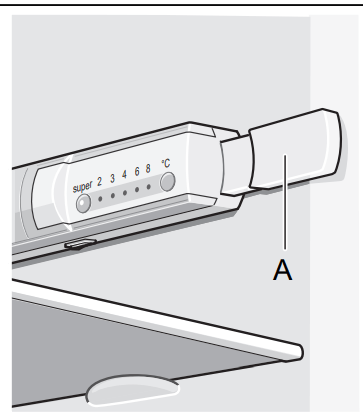 | |
| Bottom of the refrigerator compartment is wet. | The condensation channel or drainage hole are blocked. | Clean the condensation channel and the drainage hole. See chapter Cleaning the appliance 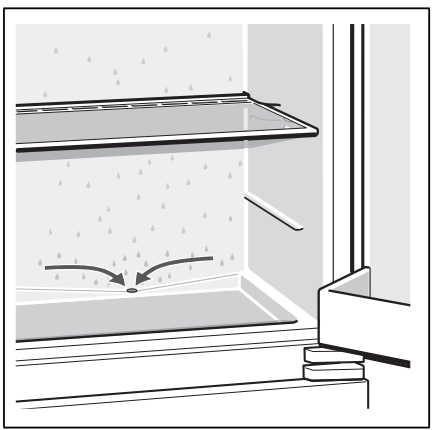 |
| The refrigerating unit is switching on more frequently and for longer. | Appliance opened frequently. | Do not open the appliance unnecessarily |
| The ventilation openings have been covered. | Remove obstacles. | |
| Large quantities of fresh food are being frozen. | Do not exceed max. freezing capacity. | |
| The temperature in the refrigerator compartment is too cold. | Freezer compartment door is open. | Close the freezer compartment door |
| Temperature has been set too low. | Increase the temperature. | |
| Super freezing is switched on. | Switch off super freezing. | |
| The refrigerating unit is switching on more frequently and for longer. | Appliance opened frequently. | Do not open the appliance unnecessarily |
| The ventilation openings have been covered. | Remove obstacles. | |
| Large quantities of fresh food are being frozen. | Do not exceed max. freezing capacity | |
Temperature display for the refrigerator compartment flashes  | Appliance opened frequently | Do not open the appliance unnecessarily. |
| Too much food was placed in the compartment. | Before placing food in the freezer, press the super button ##CP0052##. | |
| The airing and ventilation openings are blocked. | Remove obstacles. | |
| Appliance has no refrigeration capacity | ■ Appliance has been switched off. ■ Power failure. ■ The fuse has been switched off. ■ The mains plug has not been inserted properly. | Press main On/Off switch Check whether the power is on. Check the fuse.  |
| The interior light glows at a reduced luminosity when the door is almost closed (or light switch depressed). | Ambient temperature is below 20 °C or super freezing has been switched on. Not a fault! | The interior light goes out again at ambient temperatures above 20 °C or after super freezing has been switched off. |
See other models: N7140N0/01 C54L60N0GB/07 U1320W2GB/03 D94AFM1N0B/01 S213A60S0E/07
